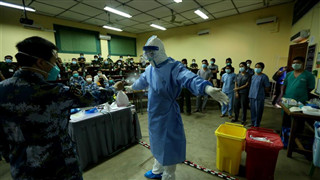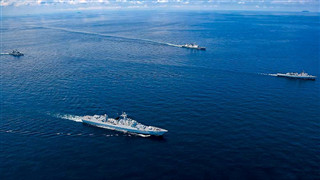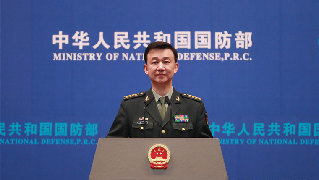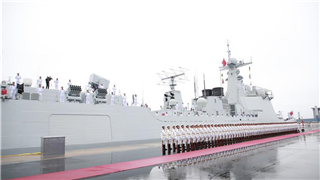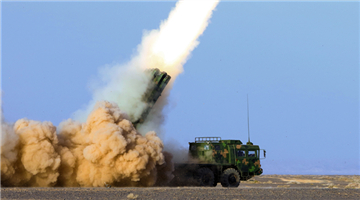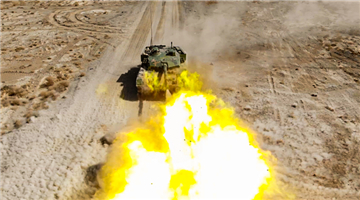By Wang Haili

The Korean nuclear issue emerged soon after the Cold War ended and has lasted nearly 30 years with growing uncertainty. Recently the Korean peninsula has come to a super critical week and the whole world is watching where it is heading.
The Korean peninsula situation has eased since 2018 and given people a ray of hope for peaceful settlement, but now it has gone back to square one after nearly two years of ups and downs, and the “normally” unsettling peninsula is back in our view. Facts have proved that the 30-year-long nuclear issue cannot be resolved by a few friendly and polite handshakes and smiles between Kim Jong-un and Donald Trump.
Will the DPRK-US conflict be settled in the same way how the US and Soviet Union ended the Cold War?
I don’t think so. The peaceful end of the Cold War was preconditioned on the disintegration of the Soviet Union, but the hardest time has passed for DPRK even though the long years of international sanctions have seriously challenged its economic development. What’s critical is that the country is relatively closed and its people are barely influenced by external thoughts. The Korean Workers Party led by Kim Jong-un is firmly in power, has full confidence in its path, theory and institution, and can flexibly adjust the nation’s security and development strategy according to domestic and international situations. As a result, the economy and people’s life in DPRK are both improving, and a Soviet-like “disintegration” is improbable. Moreover, to ensure its survival and development, the DPRK won’t easily give up its goal of “relying on nuclear force to protect ourselves, strengthen the nation and promote peace talks”, which is exactly the root cause of its confrontation against the US. Therefore, it’s unlikely the DPRK-US conflict will be settled in the same way how the Cold War was ended.
But “unlikely” doesn’t mean “impossible”. Two preconditions must be in place for the two sides to reconcile with each other without a conflict. First, for internal and external reasons, there is a pro-US “color revolution” in DPRK to push it completely to the American side; second, Washington changes its hostile policy toward Pyongyang, gives up the demand of “complete, verifiable and irreversible denuclearization” on it, and the two countries reach the agreement on “Pyongyang giving up intercontinental missiles in exchange for Washington recognizing its possession of nuclear weapons and lifting the sanctions”.
In view of the domestic situation in the two countries and regional power structure, chances are relatively small that these two preconditions will be in place, as their appearance would mean the disappearance of the foundation for the US-DPRK confrontation. The DPRK’s neighboring countries, including China, have to consider what should be done in case those preconditions did come along, as both of them are a “real big trouble” for the Northeast Asian situation.
Will there be a massive war to end the DPRK-US conflict?
I don’t think so either. There are several reasons.
First, the US cannot fight a war. The best time for the US to solve the Korean nuclear issue with a war is gone. Whether the world recognizes it or not, DPRK’s possession of nuclear weapons is fait accompli. As it develops more advanced nuclear missiles, Pyongyang now has more cards in hand, including “hostages” and the fact that the American military base in Guam and west coast are both within the shooting range of its nuclear missiles. After all, the deterrence of nuclear weapons’ destructive force cannot be ignored.
Second, the DPRK dares not fight a war. Given the sharp contrast in national strength, Pyongyang knows only too well that the day it engages in a war with Washington will be the day when its regime collapses, and the result of that war will be out of question. That’s the fundamental reason why the DPRK-US relation has never really fall over the cliff despite frequent tension in the past 30 years.
Third, surrounding countries don’t allow a war. The Korean nuclear issue concerns not only the DPRK and US, but also the security of China, Russia, ROK and Japan. Although they have different interest pursuits and advocate different approaches of settlement, the four countries have common interests in preventing war and chaos and realizing denuclearization on the Korean peninsula, and they won’t let the DPRK and US walk into war. The restraint from them is more conspicuous as the power structure in Northeast Asia and worldwide is changing.
On the early morning of December 17, Beijing Time, China and Russia jointly submitted a draft resolution to the UN Security Council on resolving the Korean peninsula issue through political means. On December 24, leaders of China, Japan and ROK gathered in China’s Chengdu city despite the peninsular tension, and reached consensus on the Peninsula issue during the tripartite meeting for the first time. All these demonstrate the changing relations and power structure among countries in the region.
How will the Korean nuclear crisis be resolved in the end?
I think the most possible resolution is in this way: after the two sides recognize the limits of each other’s power and the unbearable result through an extremely intense and dangerous conflict, only then could they come to terms in the real sense.
Though this doesn’t conform to our perception of human rationality and wisdom, history has cruelly proved it repeatedly. The mankind knew how destructive nuclear weapons were after the US dropped atomic bombs in Japan in August 1945, but it wasn’t until after the Cuban missile crisis that Washington and Moscow finally sat down and agreed on a number of military transparency measures to prevent mutual destruction. And it also wasn’t until after the United States and the Soviet Union reached a nuclear capability of "mutually assured destruction” that the nuclear crisis really disappeared. Before the Syrian war broke out, the West heard countless warnings about opening the “Pandora’s box” if it attacked Syria, but it didn’t stop until seeing the rise of IS and the overflow of Syrian refugees. Facts teach us a lesson - reconciliation is only possible after both sides test their strengths through conflicts.
Why? Famous American sociologist Lewis Coser gave his answer in The Functions of Social Conflict. “In the period of industrial and peaceful development, once provocations disrupt the established power balance to the extent of open conflict, reconciliation will only arrive by establishing a new balance of all forces that can exert impacts on the situation.”
Before and after the end of the Cold War, the power balance betweenboth sides of the 38th Parallel was broken, and the Soviet-China-DPRK alliance literally toppled, whereas the US-Japan-ROK alliance intensified instead, posing a serious threat to Pyongyang. Therefore, Pyongyang took faster steps to improve its nuclear missile capability to make up for its weaknesses and consequently secure its own survival.
With improved nuclear missile capability, Pyongyang actually obtained more initiative and influence both in the conflict against Washington and in the region, as well evidenced by the three Kim-Trump meetings since 2018 and the fact that Kim Jong-un became anhonored guest in surrounding countries. This, combined with the loosening of US-Japan-ROK alliance and its better relations with China, Russia, Japan and the ROK, as well as the relations between the DPRK and the ROK , has resulted in the most profound changes in the Northeast Asian region since the end of the Cold War.
The improved nuclear missile capability and changed regional situation are bound to affect or change the limit in DPRK-US confrontation, but how to define such change? Unlike sports contest, state-to-state confrontation has no pre-set standards, and their strength and capability can only be tested and verified in actual combats.
The removal of enmity between Pyongyang and Washington will only become a reality when they reach a power balance through conflicts. After all, mediation plans like the dual-track approach and suspension-for-suspension proposal will only be put on the negotiating table after both sides believe that they have obtained the most resources based on their strength and conditions, when reality has proved reconciliation a reasonable way out and peace is beneficial for both.
Therefore, I believe the DPRK-US reconciliation will only arrive after they find their respective limits through conflicts.
As mentioned earlier, the two countries won’t engage in a war, so their conflict will eventually come to the fore in the form of an extremely intense and dangerous military crisis that resembles the Cuban missile crisis. After that the two sides will be clear about the end of their rope on the Korean peninsula. Only then will we have an opportunity to really resolve the Korean nuclear issue, and a new, relatively stable power structure will be established on the peninsula and in Northeast Asia as a whole.
The Chinese word for “crisis” is made up of two characters as danger and opportunity. Thousands of years ago when our ancestors coined this word, they must have been fully aware that “in danger lies opportunity”.
(The author is Wang Haili, Senior Researcher at the Center for Policy Studies of the Grandview Institution)
Disclaimer: This article is originally published on Grandview Institution, and is translated from Chinese into English and edited by the China Military Online. The information, ideas or opinions appearing in this article do not necessarily reflect the views of eng.chinamil.com.cn.
